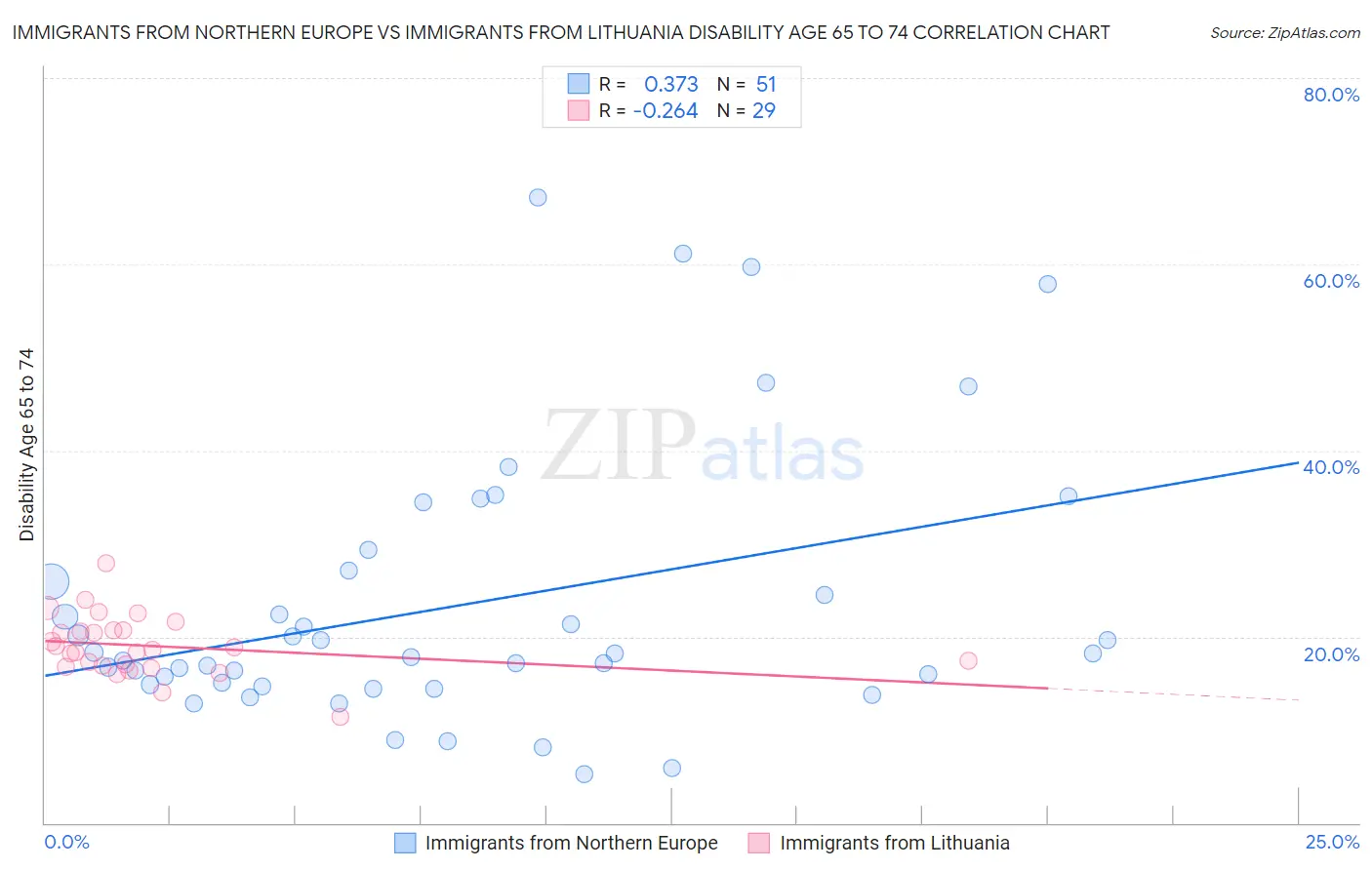Immigrants from Northern Europe vs Immigrants from Lithuania Disability Age 65 to 74
COMPARE
Immigrants from Northern Europe
Immigrants from Lithuania
Disability Age 65 to 74
Disability Age 65 to 74 Comparison
Immigrants from Northern Europe
Immigrants from Lithuania
21.0%
DISABILITY AGE 65 TO 74
99.9/ 100
METRIC RATING
31st/ 347
METRIC RANK
20.5%
DISABILITY AGE 65 TO 74
100.0/ 100
METRIC RATING
16th/ 347
METRIC RANK
Immigrants from Northern Europe vs Immigrants from Lithuania Disability Age 65 to 74 Correlation Chart
The statistical analysis conducted on geographies consisting of 476,301,514 people shows a mild positive correlation between the proportion of Immigrants from Northern Europe and percentage of population with a disability between the ages 65 and 75 in the United States with a correlation coefficient (R) of 0.373 and weighted average of 21.0%. Similarly, the statistical analysis conducted on geographies consisting of 117,698,011 people shows a weak negative correlation between the proportion of Immigrants from Lithuania and percentage of population with a disability between the ages 65 and 75 in the United States with a correlation coefficient (R) of -0.264 and weighted average of 20.5%, a difference of 2.3%.

Disability Age 65 to 74 Correlation Summary
| Measurement | Immigrants from Northern Europe | Immigrants from Lithuania |
| Minimum | 5.2% | 11.4% |
| Maximum | 67.1% | 27.8% |
| Range | 61.9% | 16.5% |
| Mean | 23.4% | 19.0% |
| Median | 18.2% | 18.6% |
| Interquartile 25% (IQ1) | 14.9% | 16.8% |
| Interquartile 75% (IQ3) | 27.1% | 20.7% |
| Interquartile Range (IQR) | 12.2% | 3.8% |
| Standard Deviation (Sample) | 14.5% | 3.3% |
| Standard Deviation (Population) | 14.3% | 3.2% |
Demographics Similar to Immigrants from Northern Europe and Immigrants from Lithuania by Disability Age 65 to 74
In terms of disability age 65 to 74, the demographic groups most similar to Immigrants from Northern Europe are Turkish (21.0%, a difference of 0.030%), Immigrants from Greece (21.0%, a difference of 0.040%), Immigrants from Japan (21.0%, a difference of 0.080%), Immigrants from Czechoslovakia (21.0%, a difference of 0.12%), and Immigrants from Sweden (21.0%, a difference of 0.22%). Similarly, the demographic groups most similar to Immigrants from Lithuania are Paraguayan (20.5%, a difference of 0.060%), Indian (Asian) (20.5%, a difference of 0.080%), Immigrants from South Central Asia (20.6%, a difference of 0.25%), Eastern European (20.6%, a difference of 0.32%), and Burmese (20.6%, a difference of 0.35%).
| Demographics | Rating | Rank | Disability Age 65 to 74 |
| Immigrants | Singapore | 100.0 /100 | #13 | Exceptional 20.4% |
| Indians (Asian) | 100.0 /100 | #14 | Exceptional 20.5% |
| Paraguayans | 100.0 /100 | #15 | Exceptional 20.5% |
| Immigrants | Lithuania | 100.0 /100 | #16 | Exceptional 20.5% |
| Immigrants | South Central Asia | 100.0 /100 | #17 | Exceptional 20.6% |
| Eastern Europeans | 100.0 /100 | #18 | Exceptional 20.6% |
| Burmese | 100.0 /100 | #19 | Exceptional 20.6% |
| Okinawans | 100.0 /100 | #20 | Exceptional 20.7% |
| Immigrants | Bolivia | 99.9 /100 | #21 | Exceptional 20.8% |
| Immigrants | Iran | 99.9 /100 | #22 | Exceptional 20.9% |
| Immigrants | Belgium | 99.9 /100 | #23 | Exceptional 21.0% |
| Soviet Union | 99.9 /100 | #24 | Exceptional 21.0% |
| Bolivians | 99.9 /100 | #25 | Exceptional 21.0% |
| Immigrants | Australia | 99.9 /100 | #26 | Exceptional 21.0% |
| Immigrants | Sweden | 99.9 /100 | #27 | Exceptional 21.0% |
| Immigrants | Czechoslovakia | 99.9 /100 | #28 | Exceptional 21.0% |
| Immigrants | Japan | 99.9 /100 | #29 | Exceptional 21.0% |
| Immigrants | Greece | 99.9 /100 | #30 | Exceptional 21.0% |
| Immigrants | Northern Europe | 99.9 /100 | #31 | Exceptional 21.0% |
| Turks | 99.9 /100 | #32 | Exceptional 21.0% |
| Immigrants | Argentina | 99.9 /100 | #33 | Exceptional 21.1% |